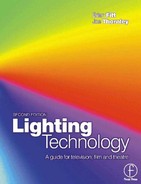Contents
2.2 Choice of light sources and luminaires
3.5 Spectral output of sources
3.7 Conversion of light in film and TV cameras
4.1 Units, terminology and calculations
4.2 Laws – inverse square and cosine
4.3 Polar diagrams and their interpretation
4.4 The measurement of colour temperature
5.3 Control of discharge sources
6.9 Centre of gravity (C of G) considerations
7.1 Suspension and why it is needed
7.8 Rigging monopoles and pantographs
8.5 Dimmer rooms and switchgear
8.8 Electromagnetic compatibility (EMC) Directive
9.3 Greenfield sites and the refurbishment of existing premises
9.4 Building construction – how it can be influenced
9.6 Television studio requirements
9.8 Air conditioning requirements
10 Lighting for locations and sport
10.4 Trussing and support systems
12.1 Sub-station and switchgear
12.2 Power and balance for three phases
12.6 Fuses and circuit breakers
12.8 Distribution on the ‘set’
13 Working lights and emergency systems
13.3 Lighting in control areas and dressing rooms
14.1 General measures for safety
14.2 Luminaires and EN 60598-2-17 (BS4533)
14.3 The Supply of Machinery (Safety) Regulations
14.4 The IEE Regulations in practice
14.5 Electricity at Work Regulations in practice
14.6 Safety checklist and inspections
15 Maintaining and hiring lighting equipment
15.1 Standardisation for maintenance and spares
15.2 Maintenance rooms and test equipment
15.4 Suspension system maintenance
15.5 Holding spares and expendables
15.6 Monitoring equipment usage for replacement programmes
